我们在使用 Sentinel DashBoard 进行Sentinel的规则设置时,一旦重启应用,Sentinel规则就会消失,在生产环境中我们需要将Sentinel规则进行持久化
GitHub地址:
规则管理及推送
一般来说,规则的推送有下面三种模式
| 推送模式 | 说明 | 优点 | 缺点 |
|---|---|---|---|
| 原始模式 | API 将规则推送至客户端并直接更新到内存中,扩展写数据源(WritableDataSource) | 简单,无任何依赖 | 不保证一致性;规则保存在内存中,重启即消失。严重不建议用于生产环境 |
| Pull 模式 | 扩展写数据源(WritableDataSource), 客户端主动向某个规则管理中心定期轮询拉取规则,这个规则中心可以是 RDBMS、文件 等 | 简单,无任何依赖;规则持久化 | 不保证一致性;实时性不保证,拉取过于频繁也可能会有性能问题。 |
| Push 模式 | 扩展读数据源(ReadableDataSource),规则中心统一推送,客户端通过注册监听器的方式时刻监听变化,比如使用 Nacos、Zookeeper 等配置中心。这种方式有更好的实时性和一致性保证。生产环境下一般采用 push 模式的数据源。 | 规则持久化;一致性;快速 | 引入第三方依赖 |
一、原始模式
这是默认模式,该模式下规则不持久化,重启微服务,配置的限流降级等规则都丢失
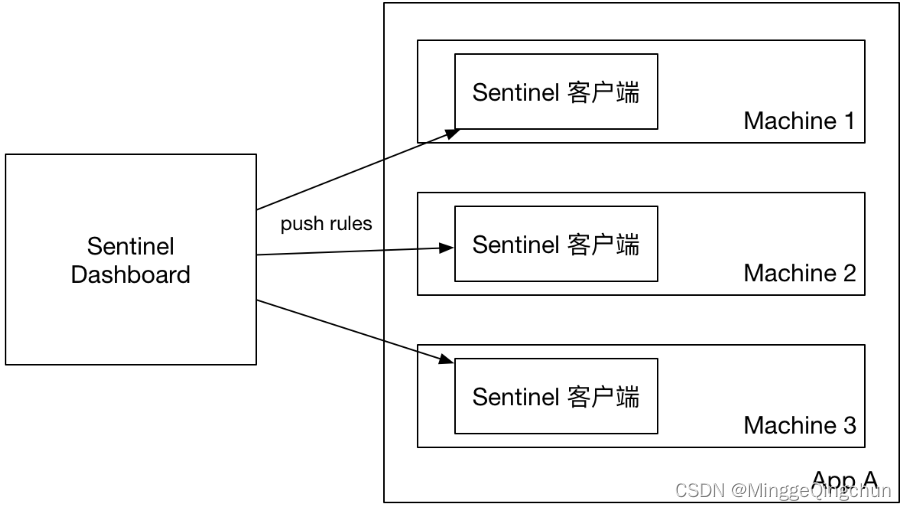
如果不做任何修改,Dashboard 的推送规则方式是通过 API 将规则推送至客户端并直接更新到内存中
这种做法的好处是简单,无依赖;坏处是应用重启规则就会消失,仅用于简单测试,不能用于生产环境
二、Pull模式(拉模式)持久化到本地
pull 模式的数据源(如本地文件、RDBMS 等)一般是可写入的。使用时需要在客户端注册数据源:将对应的读数据源注册至对应的 RuleManager,将写数据源注册至 transport的 **WritableDataSourceRegistry**中

如上图所示:sentinel dashboard推送规则给微服务,微服务将规则更新到内存,同时将规则更新到本地文件,以实现规则的持久化
这种实现方法好处是简单,不引入新的依赖,坏处是无法保证监控数据的一致性
1、 在application.properties中配置依赖;
<!--sentinel-datasource-extension数据源扩展-->
<dependency>
<groupId>com.alibaba.csp</groupId>
<artifactId>sentinel-datasource-extension</artifactId>
</dependency>
由于之前添加过了 spring-cloud-starter-alibaba-sentinel 依赖,包含了 sentinel-datasource 依赖,此处可以不加
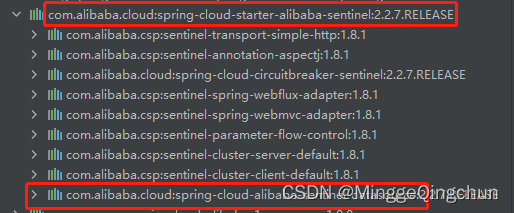
我们可以通过依赖查找是否含有依赖
pom.xml上右键->Diagrams–Show Dependencies这种方法解决时候连接线太长,不便于查找
于是安装使用 Maven Helper 插件搜索
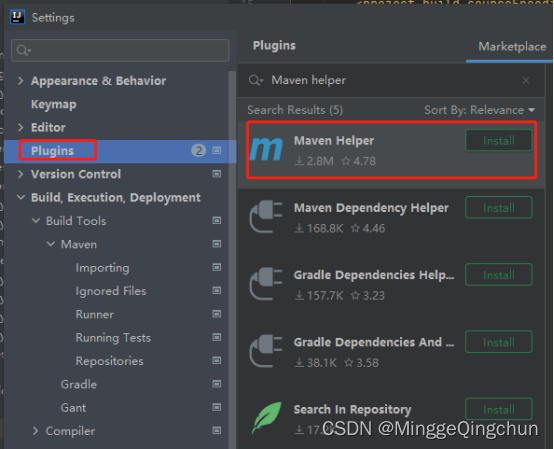
插件安装完成后打开pom.xml文件,点击底部的Dependency Analyzer选项
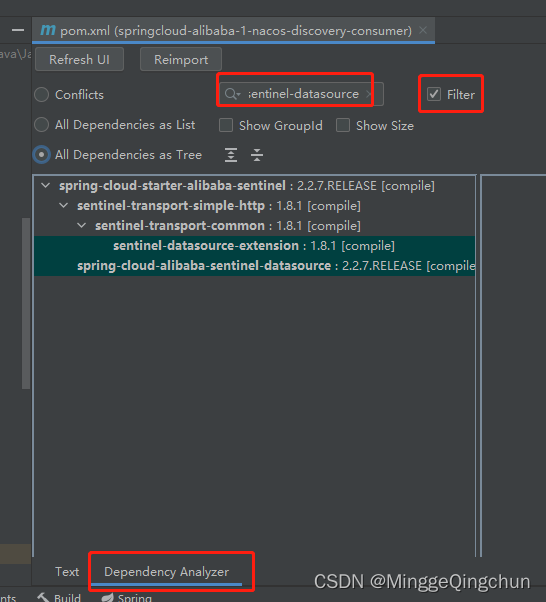
找到红色的冲突项进行排除,选择Exclude就会排除未使用到的依赖进而解决依赖冲突问题
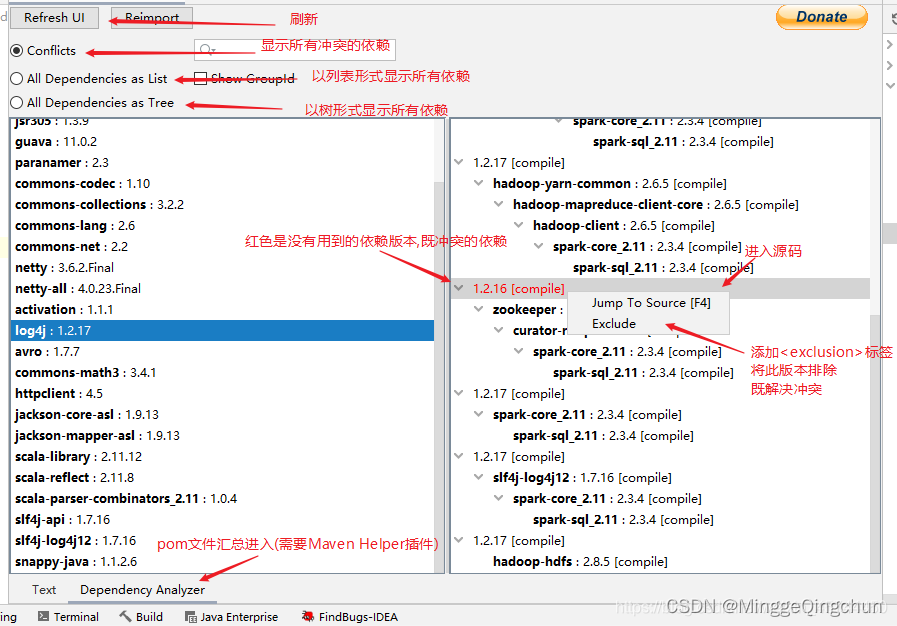
2、 自定义FileDataSourceInit类实现InitFunc(配置文件暂时不动);
import com.alibaba.csp.sentinel.command.handler.ModifyParamFlowRulesCommandHandler;
import com.alibaba.csp.sentinel.datasource.*;
import com.alibaba.csp.sentinel.init.InitFunc;
import com.alibaba.csp.sentinel.slots.block.authority.AuthorityRule;
import com.alibaba.csp.sentinel.slots.block.authority.AuthorityRuleManager;
import com.alibaba.csp.sentinel.slots.block.degrade.DegradeRule;
import com.alibaba.csp.sentinel.slots.block.degrade.DegradeRuleManager;
import com.alibaba.csp.sentinel.slots.block.flow.FlowRule;
import com.alibaba.csp.sentinel.slots.block.flow.FlowRuleManager;
import com.alibaba.csp.sentinel.slots.block.flow.param.ParamFlowRule;
import com.alibaba.csp.sentinel.slots.block.flow.param.ParamFlowRuleManager;
import com.alibaba.csp.sentinel.slots.system.SystemRule;
import com.alibaba.csp.sentinel.slots.system.SystemRuleManager;
import com.alibaba.csp.sentinel.transport.util.WritableDataSourceRegistry;
import com.alibaba.fastjson.JSON;
import com.alibaba.fastjson.TypeReference;
import java.io.File;
import java.io.IOException;
import java.util.List;
/**
* 规则持久化
*/
public class FileDataSourceInit implements InitFunc {
@Override
public void init() throws Exception {
//可以根据需要指定规则文件的位置
//"user.home" 即C盘 C:\Users\用户名 下
String ruleDir = System.getProperty("user.home") + "/sentinel/rules";
String flowRulePath = ruleDir + "/flow-rule.json";
String degradeRulePath = ruleDir + "/degrade-rule.json";
String paramFlowRulePath = ruleDir + "/param-flow-rule.json";
String systemRulePath = ruleDir + "/system-rule.json";
String authorityRulePath = ruleDir + "/authority-rule.json";
this.mkdirIfNotExits(ruleDir);
this.createFileIfNotExits(flowRulePath);
this.createFileIfNotExits(degradeRulePath);
this.createFileIfNotExits(paramFlowRulePath);
this.createFileIfNotExits(systemRulePath);
this.createFileIfNotExits(authorityRulePath);
//以下代码从官网拷贝过来
// 流控规则:可读数据源
ReadableDataSource<String, List<FlowRule>> flowRuleRDS = new FileRefreshableDataSource<>(
flowRulePath,
flowRuleListParser
);
// 将可读数据源注册至FlowRuleManager
// 这样当规则文件发生变化时,就会更新规则到内存
FlowRuleManager.register2Property(flowRuleRDS.getProperty());
// 流控规则:可写数据源
WritableDataSource<List<FlowRule>> flowRuleWDS = new FileWritableDataSource<>(
flowRulePath,
this::encodeJson
);
// 将可写数据源注册至transport模块的WritableDataSourceRegistry中
// 这样收到控制台推送的规则时,Sentinel会先更新到内存,然后将规则写入到文件中
WritableDataSourceRegistry.registerFlowDataSource(flowRuleWDS);
// 降级规则:可读数据源
ReadableDataSource<String, List<DegradeRule>> degradeRuleRDS = new FileRefreshableDataSource<>(
degradeRulePath,
degradeRuleListParser
);
DegradeRuleManager.register2Property(degradeRuleRDS.getProperty());
// 降级规则:可写数据源
WritableDataSource<List<DegradeRule>> degradeRuleWDS = new FileWritableDataSource<>(
degradeRulePath,
this::encodeJson
);
WritableDataSourceRegistry.registerDegradeDataSource(degradeRuleWDS);
// 热点参数规则:可读数据源
ReadableDataSource<String, List<ParamFlowRule>> paramFlowRuleRDS = new FileRefreshableDataSource<>(
paramFlowRulePath,
paramFlowRuleListParser
);
ParamFlowRuleManager.register2Property(paramFlowRuleRDS.getProperty());
// 热点参数规则:可写数据源
WritableDataSource<List<ParamFlowRule>> paramFlowRuleWDS = new FileWritableDataSource<>(
paramFlowRulePath,
this::encodeJson
);
ModifyParamFlowRulesCommandHandler.setWritableDataSource(paramFlowRuleWDS);
// 系统规则:可读数据源
ReadableDataSource<String, List<SystemRule>> systemRuleRDS = new FileRefreshableDataSource<>(
systemRulePath,
systemRuleListParser
);
SystemRuleManager.register2Property(systemRuleRDS.getProperty());
// 系统规则:可写数据源
WritableDataSource<List<SystemRule>> systemRuleWDS = new FileWritableDataSource<>(
systemRulePath,
this::encodeJson
);
WritableDataSourceRegistry.registerSystemDataSource(systemRuleWDS);
// 授权规则:可读数据源
ReadableDataSource<String, List<AuthorityRule>> authorityRuleRDS = new FileRefreshableDataSource<>(
authorityRulePath,
authorityRuleListParser
);
AuthorityRuleManager.register2Property(authorityRuleRDS.getProperty());
// 授权规则:可写数据源
WritableDataSource<List<AuthorityRule>> authorityRuleWDS = new FileWritableDataSource<>(
authorityRulePath,
this::encodeJson
);
WritableDataSourceRegistry.registerAuthorityDataSource(authorityRuleWDS);
}
private Converter<String, List<FlowRule>> flowRuleListParser = source -> JSON.parseObject(
source,
new TypeReference<List<FlowRule>>() {
}
);
private Converter<String, List<DegradeRule>> degradeRuleListParser = source -> JSON.parseObject(
source,
new TypeReference<List<DegradeRule>>() {
}
);
private Converter<String, List<SystemRule>> systemRuleListParser = source -> JSON.parseObject(
source,
new TypeReference<List<SystemRule>>() {
}
);
private Converter<String, List<AuthorityRule>> authorityRuleListParser = source -> JSON.parseObject(
source,
new TypeReference<List<AuthorityRule>>() {
}
);
private Converter<String, List<ParamFlowRule>> paramFlowRuleListParser = source -> JSON.parseObject(
source,
new TypeReference<List<ParamFlowRule>>() {
}
);
private void mkdirIfNotExits(String filePath) throws IOException {
File file = new File(filePath);
if (!file.exists()) {
file.mkdirs();
}
}
private void createFileIfNotExits(String filePath) throws IOException {
File file = new File(filePath);
if (!file.exists()) {
file.createNewFile();
}
}
private <T> String encodeJson(T t) {
return JSON.toJSONString(t);
}
}
3、 配置SPI(ServiceProviderInterface,JDK内置的一种服务提供发现机制,可以用来启用[框架][Link1]扩展和替换组件);
Java SPI是一种以接口为基础,使用配置文件来加载(或称之为服务发现)的动态加载机制,主要使用JDK中ServiceLoader来实现
(1)在classPath下 resources 创建路径META-INF/services/目录下 创建一个 文件 com.alibaba.csp.sentinel.init.InitFunc(以接口的全路径做为名称,不要带文件格式后缀)
(2)将自定义的类 包路径名拷贝至此(实现类的全路径)
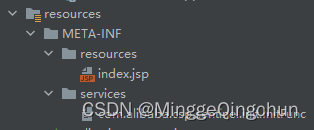


4、 启动消费者服务,此时去SentinelDashBoard中创建一条流控规则;
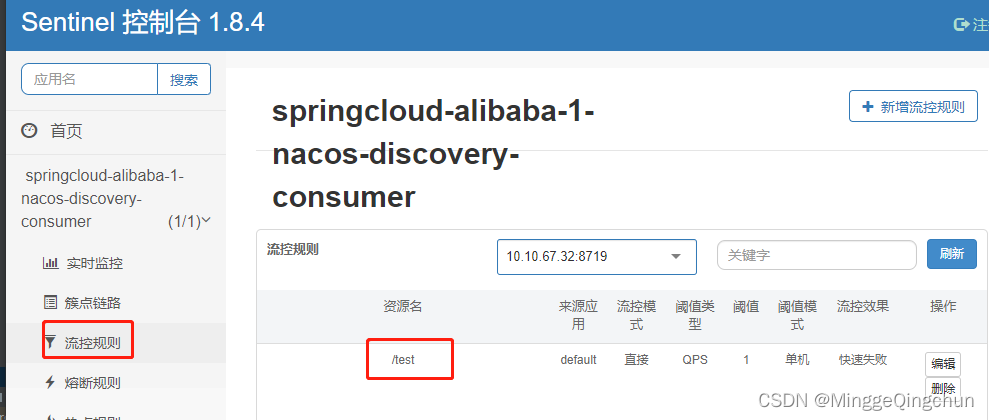
根据自定义类 FileDataSourceInit 中 存放sentinel 规则的文件夹,
即 C:\Users\用户名\sentinel\rules 可找到相应Sentinel 规则持久化的JSON文件
//可以根据需要指定规则文件的位置
//"user.home" 即C盘 C:\Users\用户名 下
String ruleDir = System.getProperty("user.home") + "/sentinel/rules";

三、Push模式(推模式)持久化到配置中心如Nacos
将规则存储在nacos配置中心,微服务从nacos配置中心获取规则,这种方式有更好的实时性和一致性保证,生产环境下一般采用该方式(支持nacos、zookeeper、Apollo等);
但是目前有一个小问题,当我们在sentinel dashboard控制台更新规则,nacos里面的规则并不能得到更新,后续的版本中可能会解决该问题

配置中心控制台/Sentinel 控制台 → 配置中心 → Sentinel 数据源 → Sentinel,而不是经 Sentinel 数据源推送至配置中心
1、 添加sentinel-datasource-nacos依赖;
<!--sentinel数据持久化-->
<dependency>
<groupId>com.alibaba.csp</groupId>
<artifactId>sentinel-datasource-nacos</artifactId>
</dependency>
2、 application.properties配置持久化数据源;
#基于nacos配置中心进行规则持久化 (利用nacos配置中心持久化流控规则)
spring.cloud.sentinel.datasource.ds1.nacos.server-addr=192.168.133.129:8848
spring.cloud.sentinel.datasource.ds1.nacos.data-id=${spring.application.name}.json
spring.cloud.sentinel.datasource.ds1.nacos.group-id=DEFAULT_GROUP
spring.cloud.sentinel.datasource.ds1.nacos.data-type=json
spring.cloud.sentinel.datasource.ds1.nacos.rule-type=flow
3、 在nacos配置中心配置流控规则;
[
{
"resource": "/test",
"controlBehavior": 0,
"count": 1.0,
"grade": 1,
"limitApp": "default",
"strategy": 0
}
]
Data ID: {spring.application.name}.json
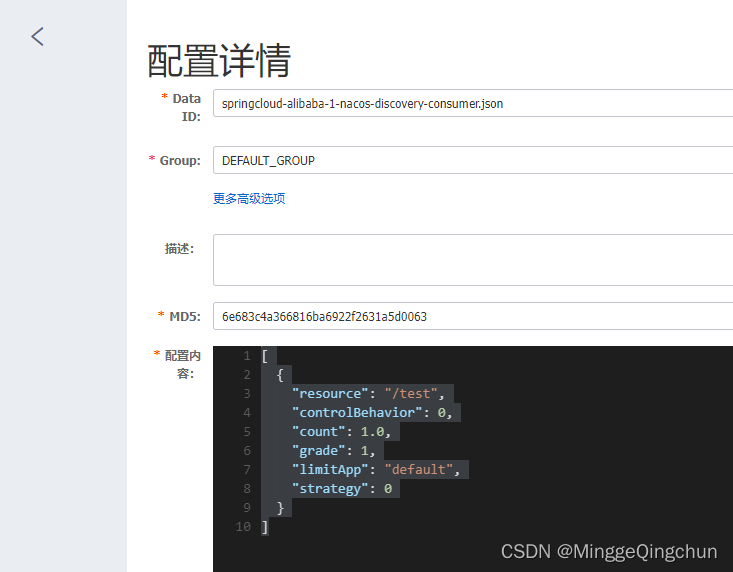
可以仿写 本地持久化的JSON文件
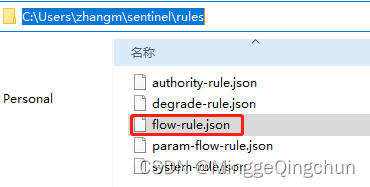
[{
"clusterConfig": {
"acquireRefuseStrategy": 0,
"clientOfflineTime": 2000,
"fallbackToLocalWhenFail": true,
"resourceTimeout": 2000,
"resourceTimeoutStrategy": 0,
"sampleCount": 10,
"strategy": 0,
"thresholdType": 0,
"windowIntervalMs": 1000
},
"clusterMode": false,
"controlBehavior": 0,
"count": 1.0,
"grade": 1,
"limitApp": "default",
"maxQueueingTimeMs": 500,
"resource": "/test",
"strategy": 0,
"warmUpPeriodSec": 10
}]
浏览器输入快速访问

注:
如果配置了 SPI 进行本地化,则要清空SPI文件内容

版权声明:本文不是「本站」原创文章,版权归原作者所有 | 原文地址: